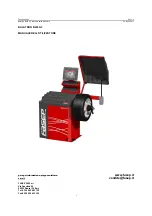
ENGLISH
ESPAÑOL
526 T
4
COD. 103933 Rev.1
DESCRIPTION OF THE MACHINE
with illustrations of the component parts relevant for use
PEDAL CONTROLS (fig. 1)(1)
The machine control pedals include:
»
Switch control pedal
(1-A) is on both sides of the machine and
rotates the chuck plate in the direction desired;
»
Bead breaking control pedal
(1-B) to activate the bead breaking
arm (2-F)
»
Open control pedal
(1-C) for opening and closing the chuck jaws (4-
P)
»
Close control pedal
(1-D) for closing the chuck jaws (4-P)
BEAD BREAKER (fig. 1) (2)
The bead breaker is a mechanism for unbeading tires from rims and is
composed of:
»
Bead breaking arm
(2-F) activated pneumatically by a double action
cylinder
»
Plate
(2-E) for tire bead breaking
»
Anti-abrasion supports
(2-G) for support during the bead breaking
phase.
COLUMN UNIT (Fig.1) (3)
The column unit is composed of a fixed column which can be tilted back
and which carries the components necessary for unmoun-ting the tire from
the rim (and for re-mounting)
»
the swinging arm
(3-H) for positioning the head.
»
the handwheel
(3M) for the adjustment of the horizontal position of
the arm:
»
locking lever (3-L) for regulating the vertical position of the rod
»
the head
(3-I) for removing (and refitting) the tire from the rim with the
help of the bead lifting lever (see accessories provided).
»
the sliding roller
(3-N), inserted inside the tongue of the head, avoids
any damage to the rim or bead.
SELF-CENTERING CHUCK (Fig.1) (4)
The chuck is the device for locking and rotating the rim. It is driven pneu-
matically two self-centring cylinders and is composed of:
»
4 slide tracks
(4-P) with 4 locking wedges (4-O) for the internal and
external locking of the rim
»
A self-centring plate
(4-Q) for rotating the rim in both directions with-
out unlocking it.
KEY
1) PEDALS
3) COLUMN
A: Switch pedal
H: Swinging arm
B: Bead-breaker pedal
I: Head
C: Open pedal
L: Locking lever
D: Close pedal
N: Sliding roller
2) BEAD-BREAKER
4) SELF-C.CHUCK
E: Bead-breaking plate
O: Locking wedges
F: Bead-breaking arm
P: Slide tracks
G: Anti-abrasion supports
Q: Self-centring plates
1
DESCRIPCION DE LA MAQUINA
con ilustraciones de las piezas componentes importantes para el
uso
JUEGO DE PEDALES (fig.1) (1)
Incluye los pedales de mando de la máquina:
»
Pedal mando invertidor
(1-A) presente en los dos lados de la máquina,
para hacer girar el plato autocentrado en el sentido deseado.
»
Pedal mando destalonador
(1-B) para accionar el brazo destalonador
(2-F).
»
Pedal mando abertura (1-C) para abrir y cerrar las mordazas del
Autocentrado (4-P)
»
Pedal mando cierre
(1-D) para cerrar las mordazas del Autocentrado
(4-P).
DESTALONADOR (fig.1) (2)
El Destalonador es el dispositivo para destalonar el neumático de la llanta
e incluye:
»
Brazo Destalonador
(2-F) accionado neumá-ticamente por un cilindro
de doble efecto.
»
Paleta
(2-E) para el destalonamiento del neumático.
»
Apoyos antiabrasivos
(2-G) para apoyar la llanta durante la fase de
destalonamiento.
UNIDAD COLUMNA (fig.1) (3)
La Unidad Columna se compone de una Columna fija que soporta los
componentes necesarios para desmontar el neumático de la llanta (y para
montarlo nuevamente):
»
el
brazo oscilante
(3-H) para la colocación de la Torre;
»
la
manivela
(3M) para el arreglo de la posición horizontal del brazo;
»
la
palanca
de bloqueo (3-L) para ajustar la posición vertical de la
barra.
»
la
torre
(3- I) para quitar el neumático de la llanta (y para montarlo
nueva-mente) con el auxilio de la palanca levanta-talones (vea
accesorios de equipo);
»
el
rodillo de deslizamiento
(3-N) insertado en la lengüeta de la Torre,
permite actuar sobre el neumático sin dañar llanta y talón.
AUTOCENTRADO (fig.1) (4)
El Autocentrado es el dispositivo para el bloqueo y la rotación de la llanta;
se acciona neumáticamente gracias a dos cilindros autocentrados y se
compone de:
»
4
recorridos móviles
(4-P) con cuñas de bloqueo (4-O) para el
bloqueo interior y exterior de la llanta.
»
un
plato autocentrado
(4-Q) para girar la llanta en los dos sentidos
sin desbloquearla..
EXPLICACION
1)
JUEGO DE PEDALES
3)
COLUMNA
A: Pedal Invertidor
H: Brazo oscilante
B: Pedal Destalonador
I: Torre
C: Pedal Abertura
L : Palanca de Bloqueo
D: Pedal Cierre
N: Rodillo de deslizamiento
2)
DESTALONADOR
4
)
AUTOCENTRADO
E: Paleta Destalonador
O: Cuñas de Bloqueo
F: Brazo Destalonador
P: Recorridos móviles
G: Apoyos antiabrasivos
Q: Plato Autocentrado
Содержание 526T
Страница 18: ...N 103946 Rev 0 526T...
Страница 20: ...N 101047 Rev 6 526T...
Страница 22: ...N 103940 Rev 0 526T...
Страница 24: ...N 103941 Rev 0 526T IT ITS...
Страница 26: ...N 103947 Rev 0 526T...
Страница 28: ...N 101045 Rev 12 OPTIONAL...
Страница 30: ...N 101039 Rev 0 526T...
Страница 31: ...N 100078 Rev 0 526T...
Страница 32: ...N 100183 Rev 0 526T...




















